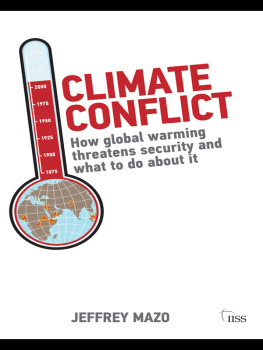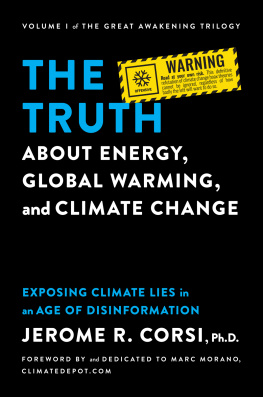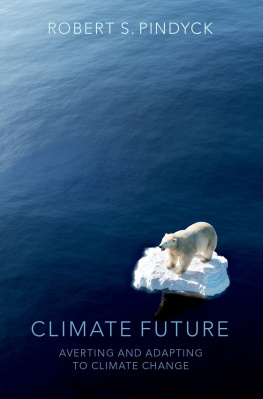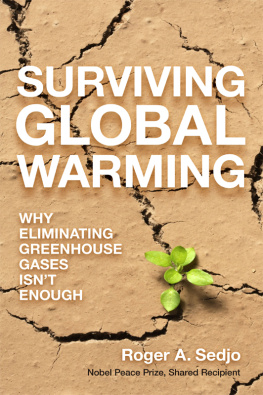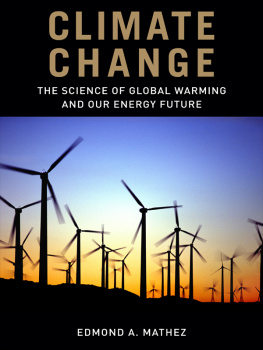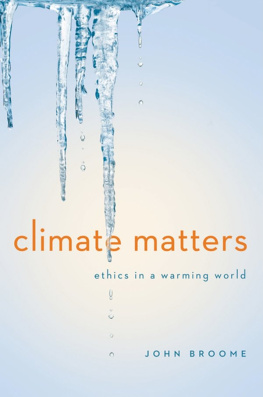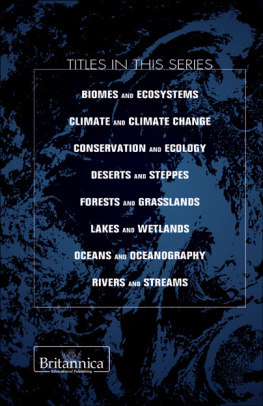The Climate Casino
The Climate Casino
Risk, Uncertainty, and Economics for a Warming World
William Nordhaus

Copyright 2013 by William Nordhaus.
All rights reserved.
This book may not be reproduced, in whole or in part, including illustrations, in any form (beyond that copying permitted by Sections 107 and 108 of the U.S. Copyright Law and except by reviewers for the public press), without written permission from the publishers.
Yale University Press books may be purchased in quantity for educational, business, or promotional use. For information, please e-mail sales.press@ yale.edu (U.S. office) or sales@yaleup.co.uk (U.K. office).
Set in 10.5/17 Meridien type by
Westchester Publishing Services
Printed in the United States of America.
Library of Congress Cataloging-in-Publication Data
Nordhaus, William D.
The climate casino : risk, uncertainty, and economics for a warming world / William Nordhaus.
pages cm
Includes bibliographical references and index.
ISBN 978-0-300-18977-3 (cloth : alk. paper) 1. Climatic changesEffect of human beings on. 2. Climatic changesEnvironmental aspects. 3. Climatic changesSocial aspects. 4. Environmental policy. I. Title.
QC903.N8545 2013
363.73874dc23
2013010722
A catalogue record for this book is available from the British Library. This paper meets the requirements of ANSI/NISO Z39.48-1992 (Permanence of Paper).
10 9 8 7 6 5 4 3 2 1
To Annabel, Margot, and Alexandra
CONTENTS
ACKNOWLEDGMENTS
The author wishes to highlight the distinguished contributions to energy modeling by the late Stanford economist Alan Manne, who pioneered research in this field with both methods and empirical modeling. Others who have participated in advancing the field and made generous suggestions and critiques to the present work include George Akerlof, Lint Barrage, Scott Barrett, Joseph Boyer, William Brainard, William Cline, Noah Diffenbach, Jae Edmonds, Alan Gerber, Ken Gillingham, Jennifer Hochschild, Robert Keohane, Charles Kolstad, Tom Lovejoy, David Mayhew, Robert Mendelsohn, Nebojsa Nakicenovic, David Popp, John Reilly, Richard Richels, John Roemer, Tom Rutherford, Jeffrey Sachs, Herbert Scarf, Robert Stavins, Nick Stern, Richard Tol, David Victor, Martin Weitzman, John Weyant, Zili Yang, Janet Yellen, and Gary Yohe, as well as many anonymous referees and reviewers.
This book has reached its elegant final form through the skilled and tireless efforts of the staff at Yale University Press here in New Haven. They have guided the author and made countless suggestions for improving both its form and substance. Particular thanks go to the Executive Editor, Jean Thomson Black, who saw it through from e-scribbles to published book and beyond. Editorial assistant Sara Hoover served as skilled problem solver. Similarly helpful were manuscript editor Mary Pasti, designer Lindsey Voskowsky, and production manager Maureen Noonan. Bill Nelson drew the art. Debbie Masi and Westchester Publishing Services moved it from electronic files to handsome printed pages. The art of book publishing is another reminder of Adam Smiths observation that the greatest improvement in the productive powers of labor [are] the effects of the division of labor.
I especially salute the memory of my teachers and sometime collaborators who pioneered in fields that were critical to development of climate-change economics, especially Tjalling Koopmans, Robert Solow, James Tobin, and Paul Samuelson. The research underlying this book has been generously supported by Yale University, the U.S. National Science Foundation, the U.S. Department of Energy, and the Glaser Foundation. This book is intended as a survey of the field rather than an original research monograph. Many of its chapters have appeared in technical form in earlier publications. However, most of the explanations, diagrams, and tables have been designed expressly for this book.
NOTE TO READERS
There are two electronic editions of this book. One is identical to the print edition and is available on various e-readers and platforms. The other is an enhanced edition that provides access to more web references, examples for further study, and interactive material that elucidates key ideas and concepts. The enhanced edition is available through Inkling.com . More details on the DICE model used in this book are available at either climatecasino.net or dicemodel.net .
PART I
THE GENESIS OF CLIMATE CHANGE
Risk varies inversely with knowledge.
Irving Fisher
1
FIRST ENCOUNTERS IN THE CLIMATE CASINO
If you read the newspaper, listen to the radio, or scan the daily blogs, you are virtually certain to encounter stories about global warming. Here is a sample from a variety of sources:
The last decade was the warmest on record.
The most inconvenient fact is the lack of global warming for well over 10 years now.
Polar bears could disappear within a century.
Global warming claims are a hoax.
The Greenland ice sheet has experienced record melting.
Clearly, global warming is getting a lot of attention today. And just as clearly, people disagree about whether it is real, whether it is important, and what it means for human societies. What should the interested citizen conclude from these conflicting stories? And if the answer is that global warming is real, how much does it matter? Where should our concerns about global warming rank among the other issues we face, such as persistent unemployment, a soaring public debt, low-intensity wars, and nuclear proliferation?
The short answer is that global warming is a major threat to humans and the natural world. I will use the metaphor that we are entering the Climate Casino. By this, I mean that economic growth is producing unintended but perilous changes in the climate and earth systems. These changes will lead to unforeseeable and probably dangerous consequences. We are rolling the climatic dice, the outcome will produce surprises, and some of them are likely to be perilous. But we have just entered the Climate Casino, and there is time to turn around and walk back out. This book describes the science, economics, and politics involvedand the steps necessary to undo what we are doing.
A ROAD MAP OF THE TERRAIN AHEAD
Global warming is one of the defining issues of our time. It ranks along with violent conflicts and economic depressions as a force that will shape the human and natural landscapes for the indefinite future. Global warming is also a complex subject. It spans disciplines from basic climate science, ecology, and engineering to economics, politics, and international relations, and the result is a book with many chapters. Before embarking on an extended journey, readers may find it useful to look at a map of what lies ahead. Here are the major themes discussed in the five parts that follow.
surveys the science of global warming. Climate science is a dynamic field, but the essential elements have been developed by earth scientists over the last century and are well established.
The ultimate source of global warming is the burning of fossil (or carbon-based) fuels such as coal, oil, and natural gas, which leads to emissions of carbon dioxide (CO). Gases such as CO are called greenhouse gases (GHGs). They accumulate in the atmosphere and stay there for a long time. Higher atmospheric concentrations of GHGs lead to surface warming of the land and oceans. The initial warming effects are amplified through feedback effects in the atmosphere, oceans, ice sheets, and biological systems. The resulting impacts include changes in temperatures as well as impacts on temperature extremes, precipitation patterns, storm location and frequency, snow packs, river runoff, water availability, and ice sheets. Each of these will have profound impacts on biological and human activities that are sensitive to the climate.
Next page


